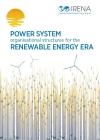

-
-
IRENA (2020) Power system organisational structures for the renewable energy era, International Renewable Energy Agency, Abu Dhabi
Copied
/-/media/Files/IRENA/Agency/Publication/2020/Jan/IRENA_Power_system_structures_2020.pdf
Copied
Power system organisational structures for the renewable energy era
Newsletter
The world’s existing electricity systems were designed mainly for conventional, centralised power generation. Large plants have generated the bulk of electricity, frequently based on fossil fuels, and dispatched it to consumers based on relatively inflexible schedules.
This prevalent system structure requires fundamental changes to accommodate the reduction of carbon-dioxide (CO2) emissions, the rise of decentralised power generation, and increased reliance on variable sources such as solar and wind power. However, misalignments between old and new system design can hinder the transition.
This report from the International Renewable Energy Agency (IRENA) examines the main misalignments between current structures, supporting policies to scale up renewables, and the essentially different requirements of a renewable-based power system. Outdated system design can constrain flexibility, limit the supply of renewable power, increase electricity costs and reinforce social inequalities, the report finds.
While some jurisdictions have found partial solutions, the need remains for a holistic view of how to change the power system. The report proposes a dual market concept, building on experiences to date with integrating renewables in various markets. It also outlines a framework to optimise the use of both capital-intensive power plants and flexible resources.
.jpg?la=en&hash=65A8886CA86AB3FF9AB1B11ABEE26546B036FFEA)




